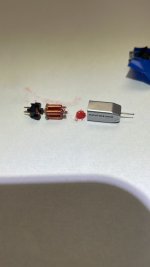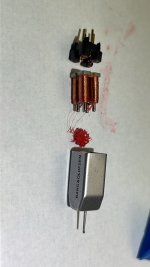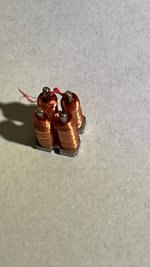Hi, i have an mmc4 stylus which had one channel not working/had very very low output. Since I’m too curious not to, I thought f*** it and opened it up.
Can anyone suggest how it is supposed to work?
I can’t find resources/ drawings or anything about the “wiring” of the coils.
After extracting the coils i noticed that part of one had become loose/ potentially even has a break in the wire except its so tiny i’ll need to get a magnifying glass.
Any advice on how to do surgery on it (if its even possible)?
Can anyone suggest how it is supposed to work?
I can’t find resources/ drawings or anything about the “wiring” of the coils.
After extracting the coils i noticed that part of one had become loose/ potentially even has a break in the wire except its so tiny i’ll need to get a magnifying glass.
Any advice on how to do surgery on it (if its even possible)?
Attachments
B&O rebuild these. In Germany: https://www.tonabnehmerservice.de/en/About-us-oxid/
The business end of the stylus has a magnet that moves within the coils, producing a small voltage on each pole. This is amplified and the result is what you hear.
The business end of the stylus has a magnet that moves within the coils, producing a small voltage on each pole. This is amplified and the result is what you hear.
The MMC stands for "Moving Micro Cross". The cartridge is a moving-iron (not moving-magnet) design as described in this article:
https://www.stereophile.com/phonocartridges/408sound/index.html
Here's an image of the moving micro cross:

This a cutaway of an MMC 3R:

Soundsmith is the leading authority on moving-iron cartridges.
https://www.stereophile.com/phonocartridges/408sound/index.html
"Moving-iron designs ... use stationary coils and magnets and a small piece of "moving iron." In the original B&O design, what moves is a cross-shaped piece of ultra-low-mass, high-purity iron attached to a soft elastomer damper stabilized in a plastic frame. The iron also incorporates a minuscule tube into which the cantilever is inserted. Each arm of the iron cross is associated with a fixed-coil/magnet structure and as the cantilever moves, it varies the distances between the four arms of the iron cross and the four fixed-coil/magnets, thus inducing tiny voltages within the coils. The advantages of this arrangement include ultra-low moving mass, even compared to an MC design; relatively high output (because the stationary magnet/coil structure can be made large); high suspension compliance; and low vertical tracking force (VTF)."
Here's an image of the moving micro cross:
This a cutaway of an MMC 3R:
Soundsmith is the leading authority on moving-iron cartridges.
In India, in the early days of quartz watches, I have seen people rewinding the tiny stepper motor coils, the wire is thin.
They used magnifying glasses, and 5 Watt soldering irons.
But the labor price in your country will be high, better get a new one, you will get a new stylus also, I think...
Rebuilt will perhaps get you a worn out or different profile stylus.
They used magnifying glasses, and 5 Watt soldering irons.
But the labor price in your country will be high, better get a new one, you will get a new stylus also, I think...
Rebuilt will perhaps get you a worn out or different profile stylus.
I hope @noisyneighbour is aware of the fact that his cartridge does not have a user replaceable stylus assembly.
When the stylus became worn the entire cartridge had to be sent back for a rebuild.
Soundsmith offer a rebuild service, but not for the MMC4 cartridge.
When the stylus became worn the entire cartridge had to be sent back for a rebuild.
Soundsmith offer a rebuild service, but not for the MMC4 cartridge.
If you can not see or measure where the wire is broken, you can throw that thingie into the thrashbox.
Its not true that B &O makes rebuild. The declined the service therefore more than 10 years ago! Complete!
Soundsmith sells spare cartridges, i have no idea if they are good or not.
Worn out stylus do not deliver no sound on one channel, they are usually louder due distorsions.
Its not true that B &O makes rebuild. The declined the service therefore more than 10 years ago! Complete!
Soundsmith sells spare cartridges, i have no idea if they are good or not.
Worn out stylus do not deliver no sound on one channel, they are usually louder due distorsions.
@Galu yep, perfectly aware of it! I was hoping there could be a way for a diy fix but seems like I'd need lots of studying, a microscope, steady hand and way more patience than what I have. And rebuilding services cost as much as a working one so it doesn't make much sense i guess... Still, really interesting design. The soundsmith article is a bloody interesting read, thanks for the link!!
- Home
- Source & Line
- Analogue Source
- B&O MMC4 - Stylus repair (help needed)


